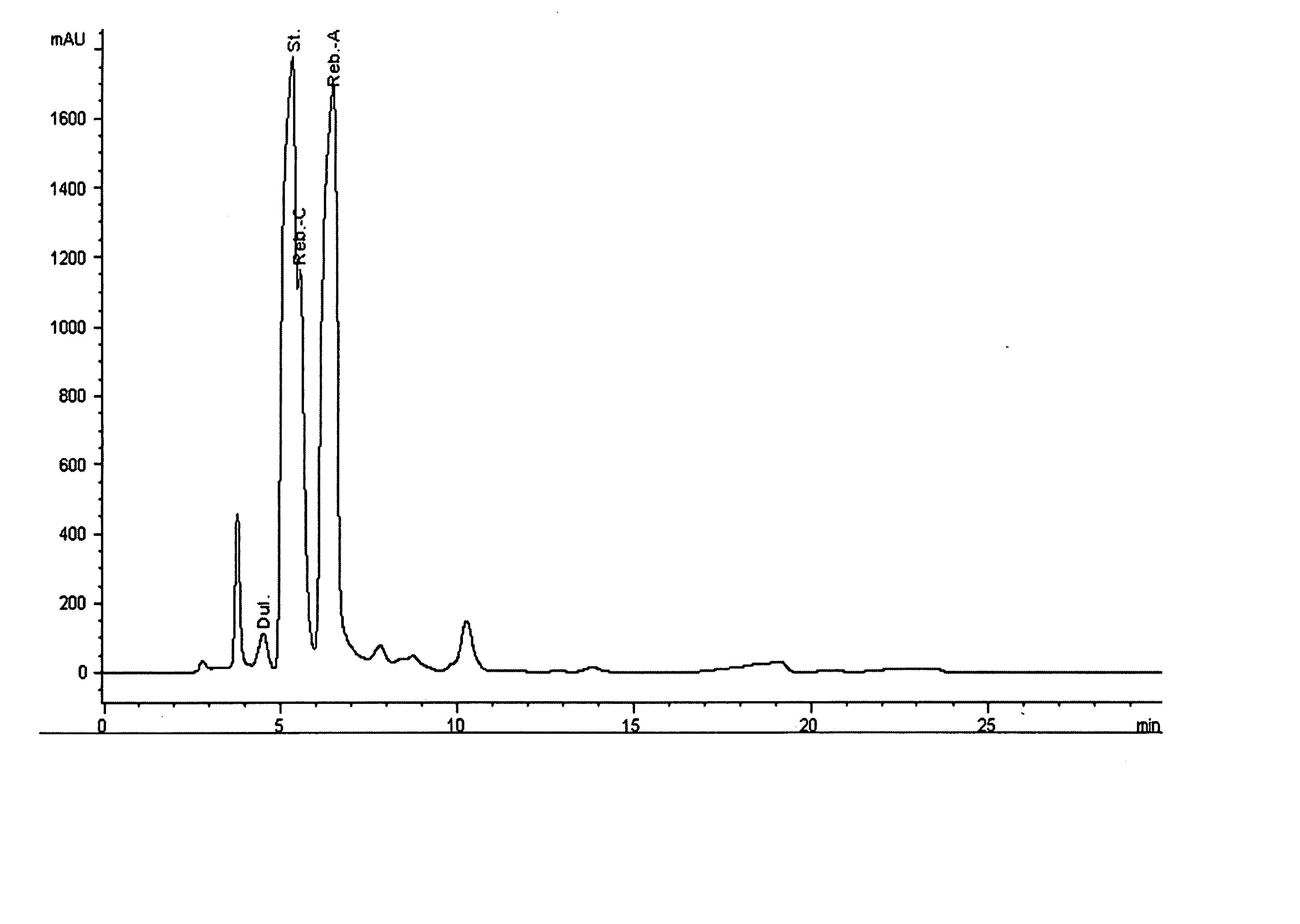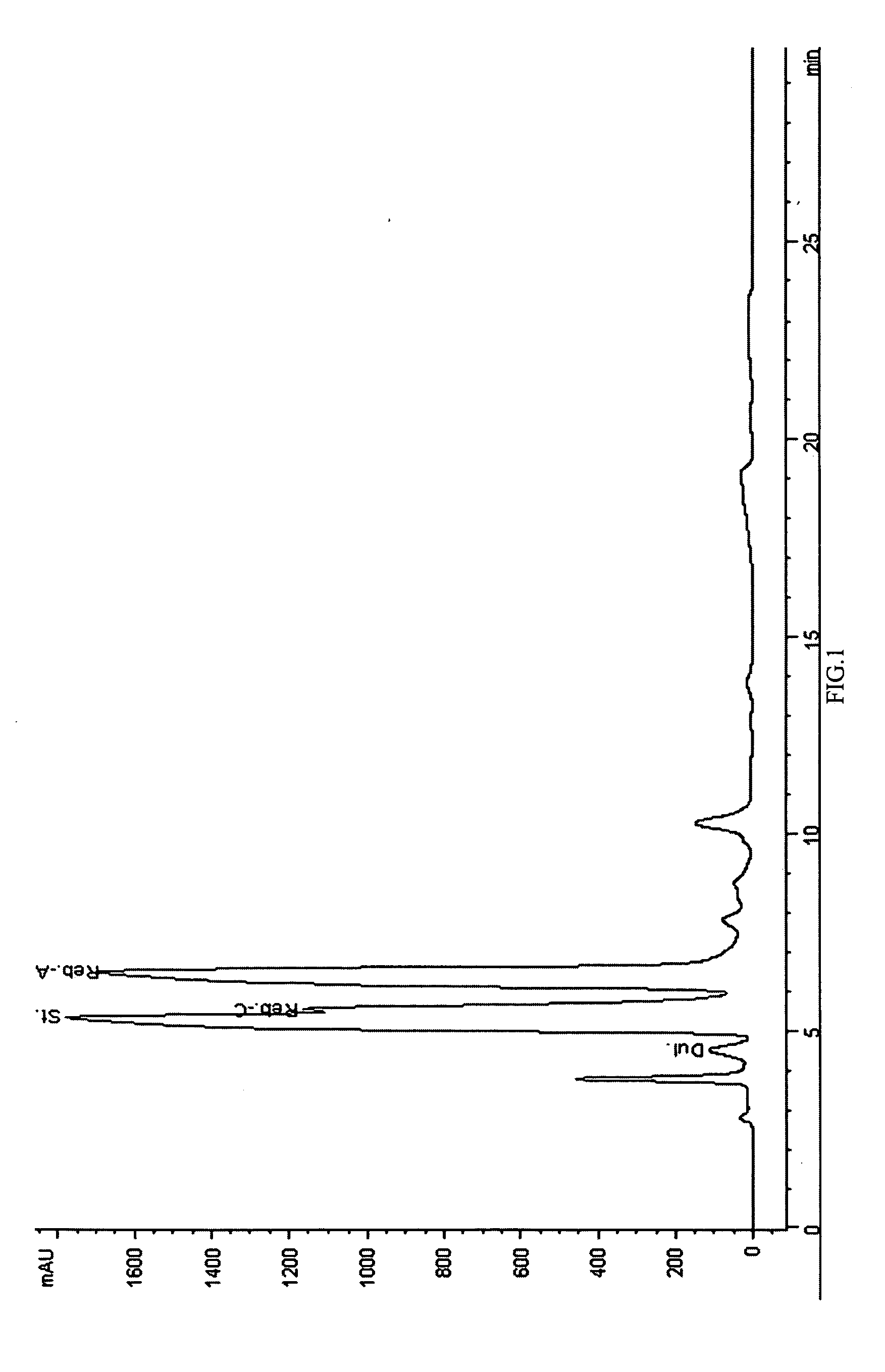Extraction, separation and modification of sweet glycosides from the stevia rebaudiana plant
a technology of stevia rebaudiana and sweet glycosides, which is applied in the direction of plant ingredients, biocide, plant growth regulators, etc., can solve the problems of quality control and flavor problems, the final product is quite impure, and the flavor of low polarity oil is unpleasant, so as to increase the transglycosylation degree and reduce the reaction time. , the effect of high transferring activity
- Summary
- Abstract
- Description
- Claims
- Application Information
AI Technical Summary
Benefits of technology
Problems solved by technology
Method used
Image
Examples
experiment 1
[0067] Experiment 1
[0068] Extraction of Sweet Glycosydes
[0069] The leaves of Stevia rebaudiana are dried at 55.degree.C. for three hour in vacuum oven and powdered (30 mesh). One kg of the obtained material was mixed with 10 liters of water (pH 6.5) and heated to 55.degree.C. with uninterruptedly agitation. 20 grams of PECTINEX Ultra-SP-L is added to the suspension and extraction is carried out at 60.degree.C. for 5 hours. The plant material is separated from the solution by filtration and the pH of the filtrate is adjusted to 10 with calcium hydroxide and heated to 55.degree.C. for 1.0 hours, cooled to ambient temperature with slow agitation, and the resulted residue is removed by filtration.
[0070] The pH of resulted filtrate is adjusted to about 7.0 with phosphoric acid, and 220 grams of beta cyclodextrin is added. The solution is maintained at 55.degree.C for 1.5 hours with agitation, then cooled to about 10.degree.C for 1 hour, and the formed precipitate is removed by filtrati...
experiment 2
[0073] Experiment 2
[0074] Separation and Purification of Rebaudioside A
[0075] Fifty grams (on the base of dry material) of the syrup obtained by the process of EXPERIMENT 1 is mixed with 0.25 liters of 96.2% of ethanol and heated to about 50.degree.C for 30 minutes with slow agitation. The mixture is cooled to the ambient temperature; the resulted precipitate is separated by filtration and dried. The powder weighed 14.2 grams and contained Rebaudioside A, 84.4%; Stevioside, 11.2%; and Rebaudioside C, 4.4%. For the further purification the powder is mixed with five volumes of 95% of ethanol, and treated as in the case of initial syrup. 10.1 grams of rebaudioside A with more than 98% of purity is obtained.
experiment 3
[0076] Experiment 3
[0077] Separation and Purification of Stevioside
[0078] The filtrate obtained in the EXPERIMENT 2 containes Stevioside, 87.7%; rebaudioside A, 0.65%; rebaudioside C, 6.8%; and Dulcoside, 4.8%. of is mixed with 2.0 w / v % of bentonite for organic systems (Sigma-Aldrich) and 2% (w / v) of beta cyclodextrin and heated at 40.degree.C for about one hour. The suspension is filtered, mixed with equal volume of distilled water, and the ethanol is removed by vacuum evaporation. Deionization of the resulted solution is developed by conventional methods using ion exchange resins, such as Dowex 50WX4-200 (H type) and Amberlite IRA96 (OH type), concentrated and dried. The resulted powder weighed 28.7 grams and contains about 93% of stevioside. For the further purification the powder is mixed with two parts of 90% of ethanol, and at 10-12.degree.C. maintained for about 30 minutes with slow agitation. The precipitate is separated by filtration and dried under vacuum. The product we...
PUM
 Login to View More
Login to View More Abstract
Description
Claims
Application Information
 Login to View More
Login to View More - R&D
- Intellectual Property
- Life Sciences
- Materials
- Tech Scout
- Unparalleled Data Quality
- Higher Quality Content
- 60% Fewer Hallucinations
Browse by: Latest US Patents, China's latest patents, Technical Efficacy Thesaurus, Application Domain, Technology Topic, Popular Technical Reports.
© 2025 PatSnap. All rights reserved.Legal|Privacy policy|Modern Slavery Act Transparency Statement|Sitemap|About US| Contact US: help@patsnap.com



